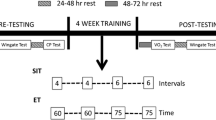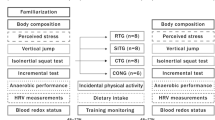Abstract
Purpose
This study was designed to examine whether concurrent sprint interval and strength training (CT) would result in compromised strength development when compared to strength training (ST) alone. In addition, maximal oxygen consumption (VO2max) and time to exhaustion (TTE) were measured to determine if sprint interval training (SIT) would augment aerobic performance.
Methods
Fourteen recreationally active men completed the study. ST (n = 7) was performed 2 days/week and CT (n = 7) was performed 4 days/week for 12 weeks. CT was separated by 24 h to reduce the influence of acute fatigue. Body composition was analyzed pre- and post-intervention. Anaerobic power, one-repetition maximum (1RM) lower- and upper-body strength, VO2max and TTE were analyzed pre-, mid-, and post-training. Training intensity for ST was set at 85 % 1RM and SIT trained using a modified Wingate protocol, adjusted to 20 s.
Results
Upper- and lower-body strength improved significantly after training (p < 0.001) with no difference between the groups (p > 0.05). VO2max increased 40.9 ± 8.4 to 42.3 ± 7.1 ml/kg/min (p < 0.05) for CT, whereas ST remained unchanged. A significant difference in VO2max (p < 0.05) was observed between groups post-intervention (CT: 42.3 ± 7.1 vs. ST: 36.0 ± 3.0 ml/kg/min). A main effect for time and group was observed in TTE (p < 0.05). A significant main effect for time was observed in average power (p < 0.05).
Conclusion
Preliminary findings suggest that performing concurrent sprint interval and strength training does not attenuate the strength response when compared to ST alone, while also improves aerobic performance measures, such as VO2max at the same time.

Similar content being viewed by others
Abbreviations
- 1RM:
-
One-repetition maximum
- ANOVA:
-
Analysis of variance
- BP:
-
Bench press
- BPM:
-
Beats per minute
- BS:
-
Back squat
- CT:
-
Concurrent training
- DEXA:
-
Dual energy X-ray absorptiometry
- ES:
-
Effect size
- GXT:
-
Graded exercise test
- ml/kg/min:
-
Milliliters per kilogram per minute
- RPM:
-
Revolutions per minute
- SIT:
-
Sprint interval training
- ST:
-
Strength training
- TTE:
-
Time to exhaustion
- VO2max:
-
Maximal oxygen consumption
- W:
-
Watts
References
Aagaard P, Simonsen EB, Andersen JL, Magnusson P, Dyhre-Poulsen P (2002) Increased rate of force development and neural drive of human skeletal muscle following resistance training. J Appl Physiol 93:1318–1326. doi:10.1152/japplphysiol.00283.2002
Ahtiainen JP, Pakarinen A, Alen M, Kraemer WJ, Hakkinen K (2003) Muscle hypertrophy, hormonal adaptations and strength development during strength training in strength-trained and untrained men. Eur J Appl Physiol 89:555–563. doi:10.1007/s00421-003-0833-3
Bachele TR, Earle RW (2008) Essentials of strength training and conditioning. Human Kinetics, Champaign
Balabinis CP, Psarakis CH, Moukas M, Vassiliou MP, Behrakis PK (2003) Early phase changes by concurrent endurance and strength training. J Strength Cond Res 17:393–401
Bassett DR Jr, Howley ET, Thompson DL et al (2001) Validity of inspiratory and expiratory methods of measuring gas exchange with a computerized system. J Appl Physiol 1985(91):218–224
Burgomaster KA, Howarth KR, Phillips SM et al (2008) Similar metabolic adaptations during exercise after low volume sprint interval and traditional endurance training in humans. J Physiol 586:151–160. doi:10.1113/jphysiol.2007.142109
Cohen J (1988) Statistical power analysis for the behavioral sciences. Lawrence Erlbaum Associates Inc, Hillsdale
Davis WJ, Wood DT, Andrews RG, Elkind LM, Davis WB (2008) Concurrent training enhances athletes’ strength, muscle endurance, and other measures. J Strength Cond Res 22:1487–1502. doi:10.1519/JSC.0b013e3181739f08
de Souza EO, Tricoli V, Franchini E, Paulo AC, Regazzini M, Ugrinowitsch C (2007) Acute effect of two aerobic exercise modes on maximum strength and strength endurance. J Strength Cond Res 21:1286–1290. doi:10.1519/R-20686.1
Gibala MJ, Little JP, van Essen M et al (2006) Short-term sprint interval versus traditional endurance training: similar initial adaptations in human skeletal muscle and exercise performance. J Physiol 575:901–911. doi:10.1113/jphysiol.2006.112094
Glowacki SP, Martin SE, Maurer A, Baek W, Green JS, Crouse SF (2004) Effects of resistance, endurance, and concurrent exercise on training outcomes in men. Med Sci Sports Exerc 36:2119–2127
Hakkinen K, Alen M, Kraemer WJ et al (2003) Neuromuscular adaptations during concurrent strength and endurance training versus strength training. Eur J Appl Physiol 89:42–52. doi:10.1007/s00421-002-0751-9
Hazell TJ, Macpherson RE, Gravelle BM, Lemon PW (2010) 10 Or 30-S sprint interval training bouts enhance both aerobic and anaerobic performance. Eur J Appl Physiol 110:153–160. doi:10.1007/s00421-010-1474-y
Hennessy L, Watson A (1994) The interference effects of training for strength and endurance simultaneously. J Strength Cond Res 8:12–19
Hickson RC (1980) Interference of strength development by simultaneously training for strength and endurance. Eur J Appl Physiol Occup Physiol 45:255–263
Hickson RC, Bomze HA, Holloszy JO (1977) Linear increase in aerobic power induced by a strenuous program of endurance exercise. J Appl Physiol 42:372–376
Holloszy JO (1967) Biochemical adaptations in muscle. Effects of exercise on mitochondrial oxygen uptake and respiratory enzyme activity in skeletal muscle. J Biol Chem 242:2278–2282
Howley ET, Bassett DR Jr, Welch HG (1995) Criteria for maximal oxygen uptake: review and commentary. Med Sci Sports Exerc 27:1292–1301
Ignjatovic A, Radovanovic D, Stankovic R, Markovic Z, Kocic J (2011) Influence of resistance training on cardiorespiratory endurance and muscle power and strength in young athletes. Acta Physiol Hung 98:305–312. doi:10.1556/APhysiol.98.2011.3.7
Izquierdo M, Ibanez J, HAkkinen K, Kraemer WJ, Larrion JL, Gorostiaga EM (2004) Once weekly combined resistance and cardiovascular training in healthy older men. Med Sci Sports Exerc 36:435–443
Izquierdo M, Hakkinen K, Ibanez J, Kraemer WJ, Gorostiaga EM (2005) Effects of combined resistance and cardiovascular training on strength, power, muscle cross-sectional area, and endurance markers in middle-aged men. Eur J Appl Physiol 94:70–75. doi:10.1007/s00421-004-1280-5
Kraemer WJ, Patton JF, Gordon SE et al (1995) Compatibility of high-intensity strength and endurance training on hormonal and skeletal muscle adaptations. J Appl Physiol 78:976–989
Kreider RB, Fry AC, O’Toole ML (1998) Overtraining in sport. Human Kinetics, Champaign
Leveritt M, Abernethy P (1999) Acute effects of high-intensity endurance exercise on subsequent resistance activity. J Strength Cond Res 13:47–51
MacDougall JD, Sale DG, Moroz JR, Elder GC, Sutton JR, Howald H (1979) Mitochondrial volume density in human skeletal muscle following heavy resistance training. Med Sci Sports 11:164–166
MacDougall JD, Hicks AL, MacDonald JR, McKelvie RS, Green HJ, Smith KM (1998) Muscle performance and enzymatic adaptations to sprint interval training. J Appl Physiol 84:2138–2142
McCarthy JP, Agre JC, Graf BK, Pozniak MA, Vailas AC (1995) Compatibility of adaptive responses with combining strength and endurance training. Med Sci Sports Exerc 27:429–436
Mikkola J, Rusko H, Izquierdo M, Gorostiaga EM, Hakkinen K (2012) Neuromuscular and cardiovascular adaptations during concurrent strength and endurance training in untrained men. Int J Sports Med 33:702–710. doi:10.1055/s-0031-1295475
Moritani T, DeVries H (1979) Neural factors versus hypertrophy in the time course for muscle strength gain. AJPM 58:115–130
Nader GA (2006) Concurrent strength and endurance training: from molecules to man. Med Sci Sports Exerc 38:1965–1970. doi:10.1249/01.mss.0000233795.39282.33
Nelson AG, Arnall DA, Loy SF, Silvester LJ, Conlee RK (1990) Consequences of combining strength and endurance training regimens. Phys Ther 70:287–294
Reed JP, Schilling BK, Murlasits Z (2013) Acute neuromuscular and metabolic responses to concurrent endurance and resistance exercise. J Strength Cond Res 27:793–801. doi:10.1519/JSC.0b013e31825c2d3e
Rodas G, Ventura JL, Cadefau JA, Cusso R, Parra J (2000) A short training programme for the rapid improvement of both aerobic and anaerobic metabolism. Eur J Appl Physiol 82:480–486
Sale DG, Jacobs I, MacDougall JD, Garner S (1990) Comparison of two regimens of concurrent strength and endurance training. Med Sci Sports Exerc 22:348–356
Staron RS, Hikida RS, Hagerman FC, Dudley GA, Murray TF (1984) Human skeletal muscle fiber type adaptability to various workloads. J Histochem Cytochem 32:146–152
Tesch PA (1988) Skeletal muscle adaptations consequent to long-term heavy resistance exercise. Med Sci Sports Exerc 20:S132–S134
Acknowledgments
This study was funded by a Graduate Student Research grant to Gregory Cantrell from the National Strength and Conditioning Association.
Conflict of interest
The authors declare that they have no conflict of interest.
Author information
Authors and Affiliations
Corresponding author
Additional information
Communicated by Michael Lindinger.
Rights and permissions
About this article
Cite this article
Cantrell, G.S., Schilling, B.K., Paquette, M.R. et al. Maximal strength, power, and aerobic endurance adaptations to concurrent strength and sprint interval training. Eur J Appl Physiol 114, 763–771 (2014). https://doi.org/10.1007/s00421-013-2811-8
Received:
Accepted:
Published:
Issue Date:
DOI: https://doi.org/10.1007/s00421-013-2811-8




